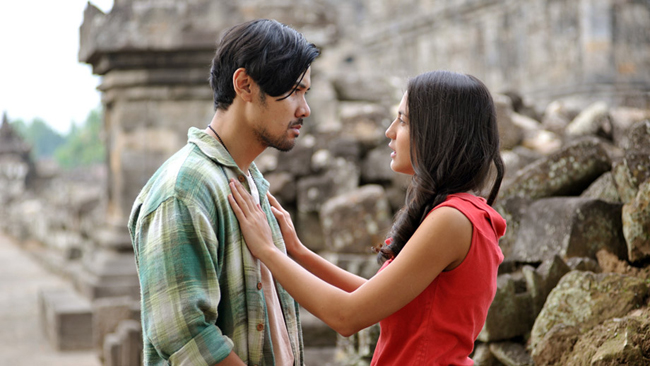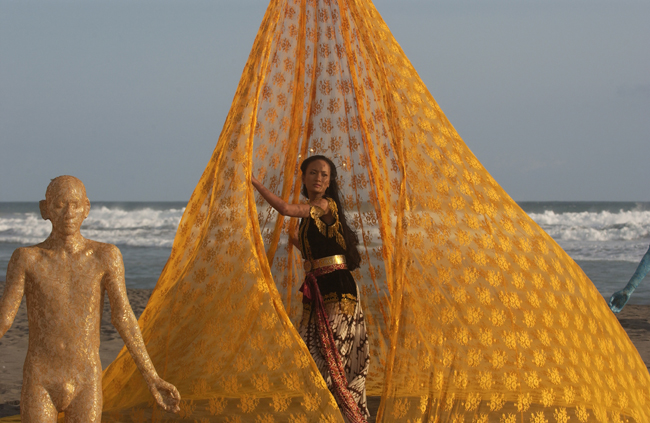About Chaotic Love Poems (2015)

Yui: I'd like to ask you about Chaotic Love Poems. You joined a big production house for the first time with this film.
Garin: The film is based on the story of Romeo and Juliet, interspersed with actual episodes from my boyhood. The main character's name is Rumi; I took it from Jalaluddin Rumi*9 . He's my favorite poet. Indonesians like Rumi's poetry. Before this film, everything I made was independent. I had never worked with a production house before, so I tried it. The script had already been finished, and the producer agreed, so we decided to produce the film. It seems he liked the poetry that appeared in the film, and I heard he actually sent it to his girlfriend, too.
*9 Jalaluddin Rumi
The greatest Islamic mystic poet in 13th-century Persian literary history. An important figure in Islamic theology and Sufism (Islamic mysticism), and founder of the Mevlevilik (Mevlevi Order), famous for its whirling dance.
Yui: Did you write poetry for this film? The music and dancing are also nostalgic.
Garin: Only one of the poems was Rumi's, and besides the one used in the "story within a story", all the rest were my originals. I used poems I wrote to past lovers—men send poetry to their lovers, you know. I'll still write it if you ask me to! (laughs) The 1970s to 1990s were a good time. A lot of good things came out of all the arts: fashion, music, even film. It's fun to depict that time period. And I included the economic crisis of the 1990s as well.
Yui: The women aren't yet wearing hijabs; they're in mini-skirts. It's similar to fashion in Japan at the time. Now, Islam more strongly influences daily life.
Garin: I think it's a little excessive. Radicalism comes not only from dogma or language, but in the form of fashion, like the hijab, of lifestyle and entertainment, as Islamic films for instance. How to wear a hijab properly is talked about on TV and such. Radicalism makes its way into daily life through television. I think the situation is becoming more complicated.
Yui: When you're surrounded by an Islamic environment, does it have an impact on your creative work?
Garin: In the past, there was strict control and censorship from the government, but now society and the populace do the censoring. Instead of government censorship, it comes from religious organizations. Even though the government will allow something to be screened after censoring, religious organizations will prohibit it from being shown. They act as if they have the power to close movie theaters. Censorship from society is harder to control. I think it's becoming more difficult and dangerous. The influence of social media is also huge. The writing culture is dying, and opportunities to speak in public places with morality are decreasing. Social media is a private place, not a public one, but even so, private statements are treated as public, which creates confusion.
About Opera Jawa (2006)

Yui: Please tell us about Opera Jawa.
Garin: In a few words, it's a Javanese dance musical, and a film that brings all the arts together. It's a highly artistic film, packed with all the elements of gamelan music, dance, fashion, installation art, theater and literature from Indonesia's leading artists.
Yui: This film is based on the story of Ramayana*10 .
*10 A major epic poem of ancient India. It is part of Hindu scripture, and one of India's two great epics, alongside the Mahabharata.
Garin: When I was an elementary school student, I had a class in which we performed Javanese musical dance drama. It's called sendratari, and we danced and performed wayang kulit*11 stories to live gamelan music. This film is an extension of that. It also adapts techniques from langendriyan, a kind of Javanese opera. My parents' home has a place for practicing Javanese dance, and since I was a child I'd been familiar with traditional performing arts. Opera Jawa just felt like returning to my childhood. It may well have been the first Indonesian film to make full use of gamelan music. I don't think there had been a film before which had dance and gamelan as a concept. Usually, Western orchestras are used for movie soundtracks, but gamelan is the biggest orchestra in the world. Why not use it for film?
*11 Traditional shadow theater using puppets, performed on the Indonesian islands of Java and Bali; also refers to the puppets used to perform.
Yui: This film received many awards overseas. Was it released in Indonesia?
Garin: In Indonesia, a general screening was held in Yogyakarta, but it ended after two or three days. It was produced in 2006, so it's a 12-year-old piece. After that, I made a trilogy of stage plays, which were performed in Europe. Exhibitions of art used in the film were also held in Paris and Munich.
Yui: Is the theme of the trilogy the same? You produced dance dramas every two or three years with Ranjang Besi (Iron Bed) in 2008, Tusuk Konde (Hairpin) in 2010, and Selendang Merah (Red Shawl) in 2013.
Garin: The theme is the same, but I change the interpretation little by little. Focusing on Hanuman*12 , then focusing on other characters, for example. Ramayana is a huge story, so it can't all fit in one piece. In addition to the dance dramas, we've done art exhibitions, taking one film and expanding it in a lot of different ways. Since Opera Jawa, I've been able to approach in that style.
*12 A monkey god of Indian myth. Avatar of the wind god Vayu.
About Setan Jawa (2016)

Yui: Ramayana was the theme for Opera Jawa. Please tell us about Setan Jawa.
Garin: Its theme is pesugihan, a kind of magic in Javanese mysticism. It's magic that makes you rich, used by spirits called Tuyul, which steal money. With pesugihan kandang bubrah (a kind of magic that brings wealth), you make a deal with a demon, and in exchange for receiving wealth, after you die, you become a pillar in your house.
Yui: You mean you won't die?
Garin: You die, but you become a pillar of the house as punishment. It's a kind of Javanese mysticism (Kejawean); there's something similar in China as well. When you cast the magic, the house breaks down many times, so you have to keep repairing it. I shot part of Setan Jawa at my parent's home—when I was a child, my house in Yogyakarta was suspected of using this magic. That's why I made it into a film, as retaliation. When I die, please look at my house. I might have become a pillar. (laughs)
Yui: The film is in black and white and is silent. It seems to have been influenced by German expressionism.
Garin: It is influenced by the German expressionist film Nosferatu – Eine Symphonie des Grauens (1922). It's the same as wayang kulit: silent, with monochrome shadows and musical accompaniment. You could say this film is a combination of German expressionism and wayang kulit. I think that the current day, in which digital technology is developing, is actually encouraging mysticism. You don't really know who is producing the news that's being exchanged digitally. The more technology progresses, the more the boundaries between truth and fiction, visible and invisible, are lost. So mysticism spreads further. I think it's interesting that mysticism is being adopted because of the digital age. The influence of mysticism can be seen in every Indonesian art: wayang kulit, paintings, literature, and so on.
Yui: Linga and Yoni symbols from Candi Sukuh (Sukuh Temple)*13 appear in the film. Does this symbolize the world before Islam?
*13 A Hindu temple in central Java. Located east of Surakarta (Solo), on the western foot of Mount Lawu. Built in the early 15th century, in the era of the Majapahit Empire. It has a main building of stone, similar to the Mayan pyramids. Stone statues and reliefs of gods and animals that appear in the Mahabharata can be seen.
Garin: The film itself is set in Java around 1926. This was the Dutch colonial era, when people were poor and relied on mysticism. It expresses magic realism, which is an art style that is said to have come to Bali from overseas around 1926. Setan Jawa could be called a magic realism film. I think it portrays the essence of magical Javanese culture.

Yui: At the screening in Melbourne, a Western orchestra and a gamelan orchestra performed together. Sound designer Yasuhiro Morinaga is in charge of the music for the Tokyo screening. What kind of music is it going to be?
Garin: It won't use a full gamelan orchestra; it may be a fusion of not only Japanese and Javanese music, but of other Indonesian music as well. Since vocals are very important, we'll use the surround system to better bring out the vocals and produce the mysticism. We're also considering adding chanting by Buddhist monks. Since the production will be unique to Japan, it may turn out completely different. In any case, I think the sound design will bring the mysticism to the forefront.
Yui: The Opera Jawa dance drama hasn't been performed in Japan yet, but Setan Jawa is going to be shown at last, along with music. This is a must-see!
Garin: I would love for everyone to see this silent black and white film accompanied by live music, and its magical world that combines German expressionism with Java's wayang kulit. Looking at my work, it's just like a "micro Indonesia". The Hijra is the story of Indonesia's first Islamic political organization since the 1800s, Nyai (A Woman from Java) (2016) is set in the early 20th century, Setan Jawa is a story from around 1926, and Soegija deals with pluralism and the independence movement around 1949. A Poet is set around the 30 September Movement in 1965, and Chaotic Love Poems portrays the 1970s to the 1990s. The 1990s onward set the stage for Love in a Slice of Bread, and Bird Man Tale portrays the emergence of regional nationalism with the advancement of decentralization since 1998. After that, since radicalism was on the rise, I shot The Blindfold, and now, LGBT issues have been drawing attention, so I made Kucumbu Tumbuh Indahku - Memories of My Body (2018). So all of my work is like a small map of Indonesia. I didn't intend for that in the beginning, but as I kept producing, it was gradually "mapped out" that way.






